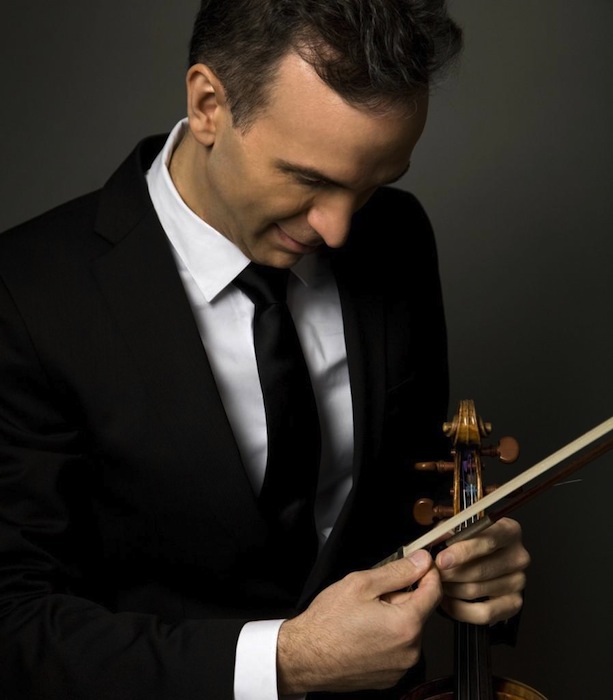Shaham shines in Bartok (and Bach) with Philadelphia Orchestra

Gil Shaham performed Tuesday night with Yannick Nézet-Séguin and the Philadelphia Orchestra at Carnegie Hall.
Yannick Nézet-Séguin is having quite a moment in New York. In the middle of a run of Otello at the Met–which has led several critics to speculate about a prominent future there–he appeared at Carnegie Hall Tuesday leading his current main endeavor, the Philadelphia Orchestra.
In past Carnegie Hall visits, Nézet-Séguin has often chosen repertoire suited to the particular strengths of his orchestra. And who can blame him? When an orchestra has a string section capable of producing such velvet, the temptation to show it off when on the road must be keen.
Tuesday night’s opener, Grieg’s iconic Peer Gynt Suite No. 1, certainly has moments for the strings to shine: in the soaring heights of “Morning-Mood,” they showed an intense sound, thick with hair, followed by warm sighs in “The Death of Åse.”
But this is really a showpiece (albeit an exceptionally goofy one) for the ensemble as a whole, and throughout the Philadelphia musicians showed both discipline and beguiling charm. Nézet-Séguin led the orchestra with an even hand, never giving in to the temptation of self-conscious bombast. The melodramatic sighs of “Anitra’s Dance” veer dangerously close to parody, and it can be difficult not to oversell the joke; like a good comic actor, Nézet-Séguin approached the music with a winning earnestness and let the humor of the piece speak for itself. A similar light touch amplified the pantomime menace of “In the Hall of the Mountain King,” which was managed with care so that the constant accelerando was barely noticeable until the più mosso was already accomplished.
It’s the winds that have to carry the opening of Sibelius’s Fifth Symphony, and Philadelphia’s had a rough time of it in the early going. There was a bit of a rasp at the start, and the back-and-forth calls felt lopsided; Nézet-Séguin’s conducting felt uncharacteristically aimless as he guided the orchestra through the initial unease.
By the time the first movement had coalesced, the performance was brimming with life. Nézet-Séguin’s aural composition is so compelling on the grand scale that it is easy to miss the subtleties that he weaves into his work: on its surface a passage might be dominated by roaring brass and percussion, but it is supported and given definition by a flurry of strings precisely traced out, as though with a compass.
He did revel somewhat too much in the sound of his strings in the Andante, leaning on texture alone without offering much direction, and as the pace built, the ensemble began to unravel slightly. The finale, though was hyper-focused, from the opening dash through the the glorious, rolling swells that form the movement’s peaks. The final detached chords were perfectly executed, bursts of sonic energy radiating and expanding to fill the hall.
The standout piece on this program was Bartok’s Violin Concerto No. 2. It’s funny now to think of Gil Shaham, once the fresh young face on the concert circuit, as the sage dean of the American school of violinists, but this he has become, and he inhabits the role well, even at the tender age of forty-four.
Shaham’s playing has changed over the years. In some ways, it feels less carefully polished—rougher, rawer, more austere. That approach is an excellent match for this concerto, a serious, often prickly piece, though with considerably more warmth than the Concerto No. 1, ducking in and out of shamelessly Romantic idiom.
The second movement began tender, kind, and unassuming, but grew in insistence until it became eerie, even slightly mad. Shaham always seemed sure of exactly where he wanted to take the music, and he guided the listener ably, whether through the wandering ruminations of the Andante tranquillo, or through the cheeky humor of the scherzando section.
The finale’s opening could have used a touch more snarl—the grinning soloist almost seems too nice a guy for the darker side of this music. Yet Shaham tackled the conclusion with determination, saving an extra dash of fire for the closing bars.
The encore that he offered, the Gavotte en rondeau from Bach’s E Major Partita, was sublime. Bursting with joy, irresistibly playful, and peppered with sparkling ornamentation in the refrain, this was some of the best Bach playing you’ll ever hear: Shaham played the movement intelligently and tastefully, but didn’t let either of those concerns get in the way of the music’s essential exuberance.




Posted Oct 15, 2015 at 8:04 am by JLC
I don’t know where Mr. Simpson was sitting when he heard the “rasp, lopsided, aimless conducting” in the Sibelius. I am a clarinet player and certainly did not hear this from a box at Carnegie Hall almost above the woodwinds. The entire Sibelius was flawless and I have never heard it played with such a wonderful sound.
For many in the audience, the Bartok was not the highlight of the evening.